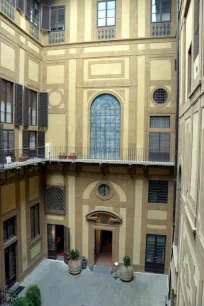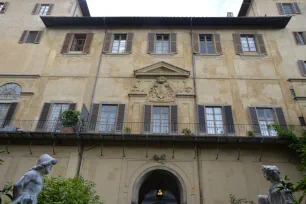For over a century, the Palazzo Medici-Riccardi was the main residence of the powerful Medici family, who reigned over Florence. The courtyards, garden and several rooms of the palace are open to visitors.


History
The construction of the palace was commissioned by Cosimo the Elder, a banker who thanks to his wealth and influence had become the de facto ruler of Florence. A first design by Filippo Brunelleschi was rejected because it was deemed too sumptuous; Cosimo didn’t like to show off his wealth and cultivated an image of sobriety. So instead he opted for a more modest-looking design by Michelozzo di Bartolomeo.
Construction started in 1444 and in 1459, before it was even completed, Cosimo the Elder took up residence in the palace. Cosimo died just five years later and would never see it completed. His son Piero and grandson Lorenzo the Magnificent embellished the interior.
In 1494, during a short-lived republican insurrection, the palace was sacked. When the Medici returned to power in 1512, they moved back into the palace. In 1539 the Medici family moved out, first to the Palazzo Vecchio and a decade later, in 1549, to the Palazzo Pitti across the river.
More than a century later, in 1659, Ferdinando II de’ Medici, the Grand Duke of Tuscany, sold the palace to Gabriello Riccardi. The Riccardi family expanded and renovated the palace in the original Renaissance style and decorated the interior in the contemporary Baroque style. When the Riccardi family went into decline, they were forced to sell the palace, and it eventually became government-owned.
The Palace
Architecture


In accordance with Cosimo’s preference, the facade of the palace along the Via Cavour is quite austere looking. The ground floor has rusticated blocks of stone; the stones on the first floor are less rough looking, while the ones on the top floor are completely smooth. The two upper levels have a repetitive pattern of round-arched windows, some of which are blind. The building is crowned with a massive cornice.
The palace became a template for new palaces in Florence, and as a result it now looks similar in appearance to many others.
Courtyards
The Medici Palace can be entered through the so-called Door of the Mules, which leads to the Courtyard of the Mules. A small corridor connects the Courtyard of the Mules with the main courtyard – known as Michelozzo’s Courtyard or Courtyard of the Columns. This elegant courtyard is surrounded by a classical arcade. The frieze above the arcade is decorated with medallions alternatively showing the Medici coat of arms and classical figures – Cosimo had a great interest in the antiquity. In the courtyard once stood a fountain with Donatello’s David statue, now on display in the Bargello. Today there is a statue of Orpheus, by Baccio Bandinelli.
Garden


Behind the Orpheus statue is the entrance to the palace garden. It was once adorned with several statues that are now in the Uffizi and the Palazzo Pitti. Today you find a typical Florentine garden with potted lemon trees and a small fountain. On one side is a statue of Hercules and opposite a limonaia – a greenhouse for lemon trees.
Interior
The palace may look unassuming on the outside, but the interior is lavishly decorated with tapestries and frescoes.
The most interesting rooms that are open to visitors are on the first floor, starting with the small Chapel of the Magi. The chapel has a beautiful marble floor and gilded ceiling designed by Michelozzo. The walls of the main room were magnificently decorated in 1459 by Benozzo Gozzoli, whose frescoes depict the procession of the Magi. Several members of the Medici family, as well as the painter himself, are portrayed in the procession. The altarpiece by Filippo Lippi is a copy; the original was sold and is now in the Gemäldegalerie in Berlin.
A staircase leads from the chapel to the Room of the Four Seasons, a council room that is decorated with Florentine tapestry depicting the seasons. On the walls of the adjoining room, the Sala Sonnino, are a series of ancient bas-reliefs that depict, among others, the mythical hero Hercules. But the most famous item in the room is the painting of the Madonna and Child by Filippo Lippi from around 1466.

The following room, the Galleria di Luca Giordano, is the most sumptuous of them all. It was built in the 1770s for Gabriello Riccardi and is abundantly decorated in the Baroque style with gold stucco, wooden panels and a grandiose ceiling fresco painted by Luca Giordano. The fresco, which stretches the length of the room, depicts the ‘Apotheosis of the Medici dynasty’ as well as several mythological scenes.
On the ground floor you can also visit some exhibition rooms used for temporary exhibitions. One of the rooms holds a collection of Roman sculptures that were acquired by Riccardo Riccardi. There’s also a multimedia lab, where visitors can obtain detailed information about the Chapel of the Magi by pointing at a multimedia display.

